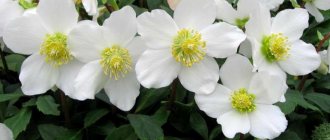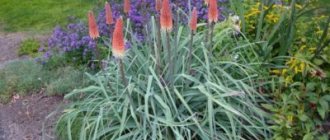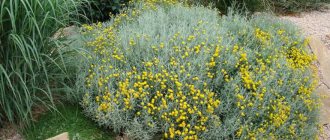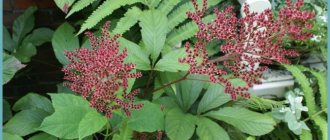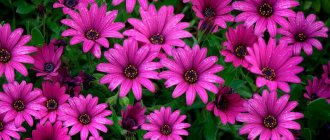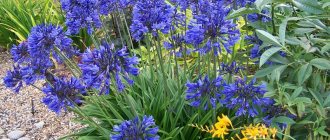The bright colors on the site are not only Asters, Azaleas, Dahlias, Gladioli, Verbena, Gaillardia, but also the “Poor Man's Orchid”. The unusual name hides a herbaceous plant from the Solanaceae family. The beauty of the buds with the spectacular color of the petals competes with many garden flowers.
In which regions is Schizanthus grown? Planting and care in open ground, preparing seedlings, planting seeds in the garden and hanging baskets, a list of cultivated species - information that will be useful to amateur flower growers and summer residents. Characteristics of species and varieties, photos of Schizanthus will help you understand which variety to choose.
Schizanthus: types and varieties for open ground
“The poor man’s orchid” is an elegant herbaceous plant with varied stem lengths: from 45 to 100 cm, there are dwarf varieties: height is about 30 cm. When creating group compositions, the area is transformed: it seems that tropical butterflies with bright wings are resting on the lush greenery. The Schizanthus flower has spectacular shades of petals: yellow, white, purple. Red, lilac, raspberry, pink look beautiful. A characteristic feature is the presence of strokes, dots, spots of a contrasting shade on the surface of the buds.
Some more facts about the "Poor Man's Orchid":
- family Solanaceae;
- annual and biennial plant (cultivated species);
- there is a soft edge on the leaves and stems;
- the buds resemble an orchid: there is a lower “lip” divided into three parts;
- many varieties have large flowers;
- dwarf hybrids are suitable for growing not only in the garden, but also as a houseplant and variety for pots and decorative baskets.
Several types of Schizanthus are used in landscape design, described below.
Visetonian
A hybrid plant, a popular variety suitable for growing in temperate climates. A large number of varieties and garden forms. The flowers are quite large, the stems and greenery have a pleasant edge, the petals are covered with stripes and small spots. Spectacular appearance, highly decorative.
Pinnate
An annual with bright purple flowers, the split “lip” has purple dots. The height of the plant is up to 50 cm, the greenery has a slight edge.
Graham
Annual plant. The species was cultivated at the end of the 19th century. The height of the bush is up to 60 cm. The edge is less pronounced than that of other varieties. The buds are bright pink, the petals have deep red streaks and yellow spots. Based on Schizanthus Graham, many hybrids with interesting bud colors have been bred, including snow-white, scarlet and lilac shades.
Description
Schizanthus has a special structure. Particularly original are the flower petals, thanks to the shape of which the plant got its name, since “schizanthus” in Greek means “split flower”.
Many find a surprising external resemblance between the blooming schisanthus and an equally charming flower - the orchid.
People also call this plant “butterfly flower”. And this is no coincidence, since the petals of this bright plant are very similar in appearance to the wings of a fluttering insect.
Schizanthus is a plant that belongs to the category of perennials. However, taking into account climatic conditions, in mid-latitudes it is considered only as an annual flower crop. There are several varieties of schisanthus varieties, differing from each other in stem height, which varies from 30 to 100 cm, and the color of the petals.
The flowering period of this crop is quite long. The plant begins to delight with its luxurious flowers in May and continues until frost arrives. Schizanthus is thermophilic, so when the temperature drops noticeably, it stops delighting with its unique flowering.
Flower growers love to decorate their plots by planting popular varieties of schisanthus. Designers are attracted by the wide range of different shades in which the petals of this delightful flower are painted.
However, it is not only the bright color that attracts the attention of gardeners. The originality of the petals is not limited to color; unique spots, strokes and unique patterns can be seen on them
Growing from seeds to seedlings
There are two methods:
- first - the seeds are sown in a container in August-September, they wait until the seedlings grow up, the seedlings are picked, and wintering takes place in a well-lit but cool room. In the spring, after the onset of warmth, young bushes are transplanted to the site;
- second. The beginning of March or the last ten days of February are the dates when flower growers begin to germinate seeds. When the soil warms up and frosts disappear, the hardened, grown seedlings of the “Poor Man's Orchid” are transplanted into the garden.
Soil and container
Seedlings are grown in a small container. It is important that the container has holes for water drainage and enough space to grow the entire batch of seeds.
A mixture of peat and sand in equal proportions is a suitable basis for growing schisanthus.
Nutritious and light soil is suitable for seed germination. It is useful to disinfect the soil mixture using a strong solution of potassium permanganate or special antifungal agents - fungicides. You can calcinate the purchased or prepared substrate in the oven: with this processing method, mold spores, dangerous microorganisms, larvae and other harmful elements will certainly die. Important! Unfortunately, purchasing a ready-made soil mixture does not provide a 100% guarantee that the basis for growing indoor flowers is free of fungus, dangerous bacteria, small larvae or parasite eggs. For this reason, experienced gardeners advise always calcining the soil from the bag in the oven or thoroughly watering the base with disinfectants.
Planting seeds
Helpful Tips:
- pour the prepared soil into a container, distribute it over the container, water it, let the liquid absorb;
- spread the seeds of the “Poor Man’s Orchid” on the surface, pour a small layer of soil on top;
- cover the container with cellophane or glass;
- Place a mini-greenhouse in a room where it is light and warm, but not hot;
- every two days, remove the covering, collect drops of condensation, and ventilate the substrate for 15 minutes to prevent mold from forming;
- with good care, the sprouts make their way to the top in 15–20 days;
- a couple of days after the end of the “black earth” period (before the first seedlings appear), open the container so that the seedlings do not rot.
Conditions for successful bush growth
In order for the ornamental shrub to grow well, choose a warm, well-lit place. The soil should have good drainage, and subsurface water should not come close to the surface. The seedlings should not have damaged leaves.
On damp, clayey soils it dies, on fertilized soils it grows well, and poor soils stimulate its flowering. It is better to choose dry soil with good water and breathability.
Recent Entries
Chainsaw or electric saw - what to choose for the garden? 4 mistakes when growing tomatoes in pots that almost all housewives make Secrets of growing seedlings from the Japanese, who are very sensitive to the soil
Seedling care
The rules are simple, but they must be followed. If the recommendations are not followed, the seedlings become thinner, weaker, and less prepared for transplanting to the site. If the seedlings grow poorly, then the timing of planting the young schisanthus in the ground will shift. It is no less harmful if the seedlings “stand still”: they stretch out at a time when the soil and air are still slightly warmed up.
Main aspects of caring for seedlings:
- Watering. The soil should be moist and the addition of liquid should be moderate. It is important to defend the water. Water the seedlings carefully, making sure that moisture does not get on the leaves. In a cool room, you should not frequently moisten the substrate to avoid dampness and the risk of mold.
- Illumination. Seedlings should not be kept in a poorly lit room: seedlings are drawn to the sun, become very thin, and weaken. It is important that the container does not stand on a windowsill exposed to direct sunlight.
- Temperature. Unlike many types of garden plants, growing schisanthus seedlings does not require a temperature of +18 degrees after germination of the seedlings. The best option is to place the container with sprouts on the veranda or cool balcony, where the indicators are around +15 degrees. At this temperature, the seedlings will have time to get stronger and grow moderately by the time it is warm enough outside and the frosts stop.
- Picking. You will have to wait until three or four leaves appear on the young schisanthus. After picking, the plants are kept in individual containers: fairly large pots. You can take large peat cups. If the seedlings are a little sick after transplanting, then it is useful to water the plants with Zircon or Fitosporin: immunomodulators and biostimulants reduce the influence of stress factors.
- Hardening. Preparation of plants for planting begins in the third decade of May. First, the cups with sprouts are taken out into the garden or onto an open balcony for 15 minutes, then for half an hour, and so on. Before planting on the site, schisanthus seedlings should spend almost the entire day outside, including at night. If the grower skips the stage of hardening the seedlings, then the young plants adapt less well to environmental conditions, grow weaker, and do not bloom as profusely. Harden off the seedlings in a place where there are no drafts or direct sun.
Transplanting
It is important to wait until the moment when you don’t have to worry about return frosts. Plant the "Poor Man's Orchid" in a lighted area.
Useful tips:
- Shortly before planting, the area is carefully dug up, and humus or peat is first added. It is important to remove weeds and check if the substrate is swampy.
- To plant seedlings, choose a quiet day, without sharp gusts of wind, rain or fog. For seedlings, dig shallow holes. A distance of about 25 cm is maintained between adjacent holes to avoid dense plantings and problems associated with an excess of plants on the site.
- They use exclusively the transfer method: carefully remove the seedlings from the containers (peat pots are placed in the ground along with the sprouts), make sure that the earthen lump on the roots is preserved, and plant the plants in the holes.
- After planting, add soil, compact it a little, and moderately moisten the substrate.
- It is useful to immediately dig long, thin, but strong pegs near each plant: schisanthus is actively growing, thin stems bend under the weight of the leaves and their own weight. Support is especially necessary for medium-growing and tall varieties. The central shoot is tied to a long peg, making sure that the stem is not too compressed.
Outdoor care
The exotic plant is increasingly being planted on the site by amateur flower growers and summer residents. The “poor man's orchid” not only pleases with its spectacular flowering, but also makes significantly fewer demands on growing conditions. Unlike the capricious indoor species Vanda Orchid and Dendrobium Orchid, the Schisanthus flower is unpretentious and takes root well in open ground.
Watering
Most garden plants like moderate soil moisture. Dry clods of earth and dense crust should not be allowed, but you should not create a “swamp” in the flowerbed. Excess moisture is a direct path to rotting of the underground part, and with a lack of water, the growth of schisanthus slows down, the decorative effect decreases, the leaves wither and dry out, and the flowers crumble.
For irrigation, the water must be left to stand for two days. Moisten the soil from a watering can with a long spout, pour the liquid carefully, closer to the stem.
Advice! When watering, you need to make sure that the stream of water does not fall on the flowers: the petals fall off and become wrinkled, which reduces the attractiveness of the plantings.
Feeding and fertilizer
Even in fertile soil, the Poor Man's Orchid needs periodic feeding. From spring until the end of flowering, complex mineral fertilizer is applied twice a month. It is important that by the time the buds are released, the fertilizer contains more potassium and phosphorus. With the beginning of flowering, the frequency of applying nutrient mixtures is changed: compounds are added every week, but the concentration is reduced by 2 times.
Be sure to water the soil before applying mineral fertilizers. The granules should not fall on leaves and flowers.
Mulching, loosening
It is useful to sprinkle the soil around grown plants with a layer of organic matter, such as peat. Before mulching, be sure to remove weeds, water the plants, and thoroughly loosen the soil. The mulch layer is moderate: approximately 1 cm.
Periodically loosen the ground around the bushes. It is important to be careful not to damage the delicate stems and flowers. The formation of a dense crust and salt deposits should not be allowed. Timely loosening and mulching reduces the risk of substrate salinization and prevents drying out of the soil and roots.
Care during and after flowering
With the beginning of budding, feed the plant more often than before (once every 7 days), making sure that the soil is always moderately moist. It is important to remove weeds in time; in dry years it is useful to mulch the soil around the bushes after watering.
If the plantings are not very large, and there is easy access to the “Poor Man’s Orchid,” then it is advisable to carefully remove faded elements so that the plant spends less nutrients on wilted buds. Be sure to loosen the soil for high-quality aeration of the substrate.
Protection from pests and diseases
The problem of many plants from the Solanaceae family is sensitivity to fungal infections, schisanthus is no exception. Excessive watering without taking into account the ambient temperature is the main cause of rotting of the underground part, stem and leaves. The fungus can get onto a plant with contaminated soil if the grower does not disinfect the soil mixture with fungicides, a strong solution of potassium permanganate, or forgets to calcine the soil in the oven.
Gray, black, off-white or brown bloom, wilting leaves, weak growth are signs of fungal infections. It is important to change the conditions of detention to stop the proliferation of harmful microflora. All parts of plants affected by the fungus are removed without regret; if necessary, bushes are dug up, and the area is cleared in case of severe mycosis. If the disease is only at the initial stage, then the flowers can be saved: the stems, leaves, buds are carefully treated with fungicides, and the substrate is watered with a working solution. It is important to adhere to the optimal concentration for each drug and re-treat if necessary.
Tender leaves and stems attract pests. Thrips, whiteflies, aphids, and spider mites are “particularly partial” to the nightshade family. Folk remedies repel parasites: soap solution, wormwood tincture and garlic infusion. When there is a large population of harmful insects, schisanthus plantings are sprayed with insecticides: Aktara, Fitoverm, Aktellik. When identifying spider mites, chemicals from another group are needed - powerful acaricides: Neoron, Flumite, Anti-mite.
When using pest control products, it is important to wear closed clothing, gloves, a respirator, and plastic goggles. You cannot be negligent about the rules of protecting the body: many chemicals have hazard classes 3 and 2, which can lead to severe intoxication if inhaled vapors or contact with liquids. During treatment, smoking, eating, and drinking are prohibited. After completing the procedure, be sure to thoroughly wash your clothes, wash your face, and rinse your mouth. Eating is allowed a couple of hours after disinsection, not earlier.
Disease and pest control
Exotic schisanthus are susceptible to various diseases and pest attacks. The most common diseases:
| Anthracnose | It occurs due to high humidity, deficiency of phosphorus and potassium in the soil, and its excessive acidity. Signs: brown putrid spots on leaves and petals. The disease leads to the gradual drying out of the plant |
| Pythiosis | Rot affecting the rhizome. The cause of the appearance is an excess of moisture from too frequent watering or an increased amount of nitrogen fertilizer. |
| Late blight | A fungal disease that affects the leaves of a flower. Symptoms: the appearance of brown spots and plaque. If you cut off the leaf affected by the fungus in a timely manner and treat the cut site, there is a chance to save the schisanthus. The infected flower must be isolated; others must be treated with a fungicide or other preparation containing copper for prevention. |
The most common pests that attack flowers:
| whiteflies | small flying parasites similar to moths |
| aphid | small green or black insects, the worst pests |
| thrips | tiny insects with an elongated body, particularly persistent parasites |
They are controlled using various insecticides.
Reproduction
The "poor man's orchid" is grown from seedlings; in warm regions, gardeners sometimes plant the seeds directly into the ground. The first method is widespread, and sowing grains without going through the seedling stage is used very rarely.
Schizanthus reproduces well by self-sowing if the spring is early, warm, and frosts quickly disappear. You can experiment and see if the seeds of the “poor man’s orchid” will germinate if you don’t work with the seedlings. There are other plants that are more resistant to the environment. They can be grown using the seedless method, provided the climatic conditions are suitable.
Autumn care
In regions with frosty winters, schisanthus bushes should not be left outside: the exotic plant will probably freeze to death. You can dispose of the flowers or carefully dig them up and keep them in the house or on the veranda throughout the winter. The area must be dug up so that the larvae of harmful insects, which freeze out in the cold, appear on the surface.
Wintering of biennials, which in the central zone are often grown as annual plants, takes place indoors. Many gardeners carefully dig up the Poor Man's Orchids bushes, move them into their homes, plant them in flowerpots, and keep them all winter in a cool but bright room. Watering and fertilizing are moderate; the soil should not be allowed to become excessively damp to avoid rotting.
Schizanthus in landscape design
“Poor Man's Orchid” looks impressive in group plantings, when decorating flower beds and lawns. Herbaceous plants with bright flowers highlight the vibrant green of the lawn. You can plant schisanthus in large vases to decorate the patio or plant an exotic species in a large clearing near the recreation area.
Dwarf varieties (two or three varieties with contrasting or matching petal shades) are often placed in vases or hanging planters. It is important to create elegant paths or arrange a geometric or fantasy pattern (the basis is a layer of decorative mulch) in order to approach plantings without obstacles and comfortably care for delicate plants.
Is it time to update the assortment of garden plants on your site? Experienced flower growers advise taking a close look at the “Poor Man's Orchid”. Such a delicate plant as Schizanthus looks great in any corner of the dacha and garden. Photos help to understand why flower growers around the world highly value this exotic plant with small and medium-sized flowers of various colors. Unlike the capricious beauty of the Orchid, growing Schizanthus does not cause much trouble.
Video about the rules for growing Schizanthus seedlings, as well as about planting a flower with an amazing color that will not leave you indifferent:
Sowing on the ridge
In the southern regions, seeds sown in the II-III decade of April, in temperate latitudes - in the II-III decade of May, will quickly sprout, and in July beautiful bright flowers will appear in the flower garden, which will delight until late autumn. To get long and continuous flowering, not all seeds are sown at once, but at intervals of 4-5 days.
A site for a heat-loving crop is chosen in a bright place and with slight shading if it is hot and dry in summer. The ridge is first dug up, the surface is leveled - the water should not drain and wash away the seeds. In a low area with stagnant moisture, you can build a bulk layer.
Seeds are sown in the same way as for seedlings, after which the bed is covered with spunbond or a small greenhouse is installed. Seedlings require moist soil, so do not allow it to dry out. After 1.5-3 weeks, the first shoots should appear.
Dense seedlings are thinned out after the formation of two leaves, and the removed seedlings can be planted.
